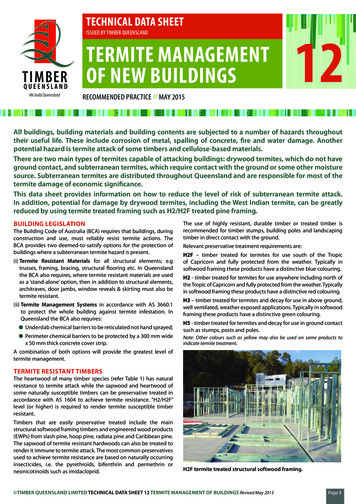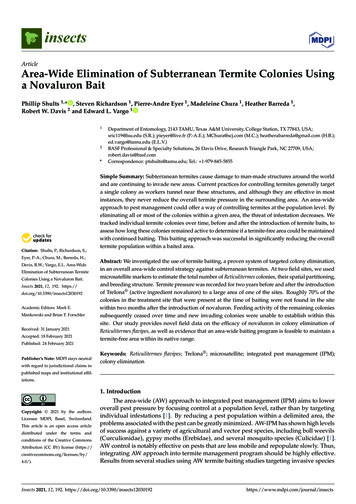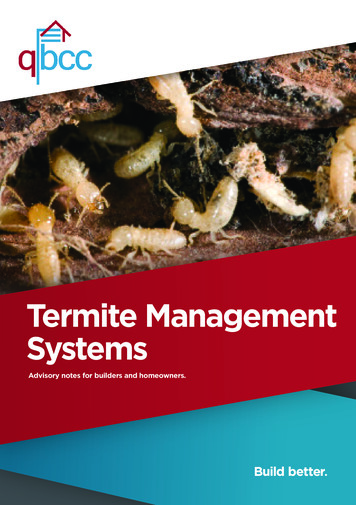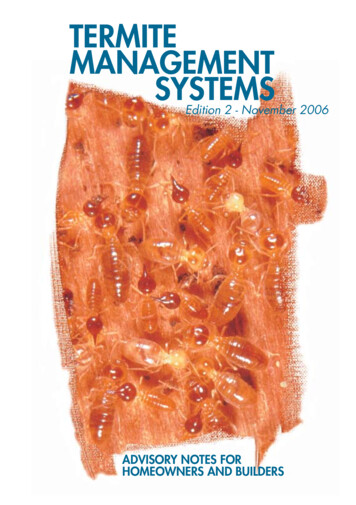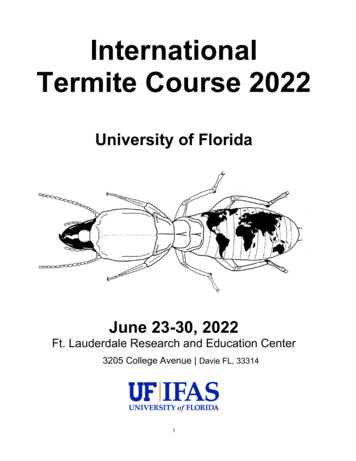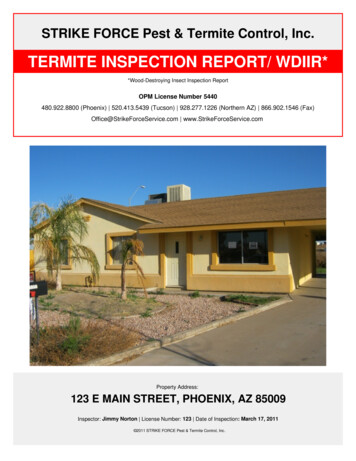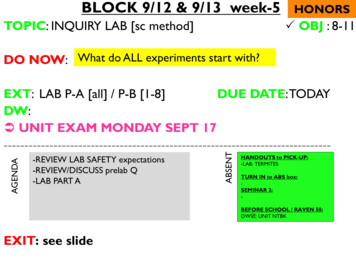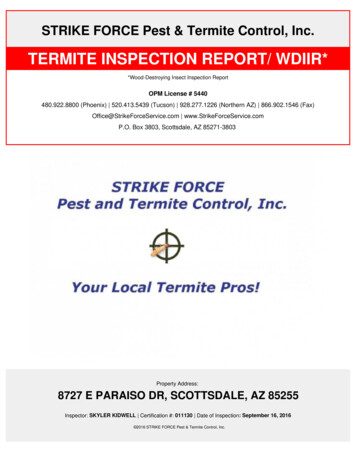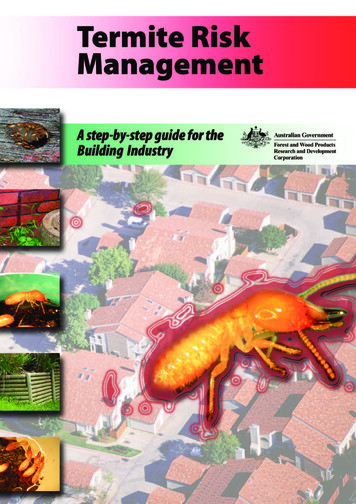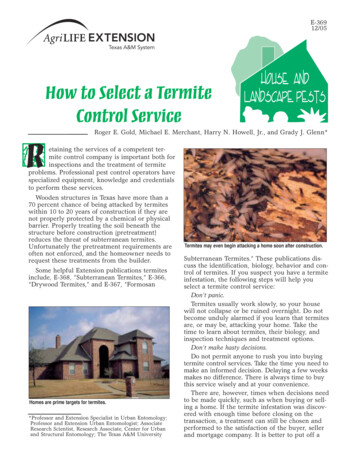
Transcription
E-36912/05How to Select a TermiteControl ServiceRoger E. Gold, Michael E. Merchant, Harry N. Howell, Jr., and Grady J. Glenn*Retaining the services of a competent termite control company is important both forinspections and the treatment of termiteproblems. Professional pest control operators havespecialized equipment, knowledge and credentialsto perform these services.Wooden structures in Texas have more than a70 percent chance of being attacked by termiteswithin 10 to 20 years of construction if they arenot properly protected by a chemical or physicalbarrier. Properly treating the soil beneath thestructure before construction (pretreatment)reduces the threat of subterranean termites.Unfortunately the pretreatment requirements areoften not enforced, and the homeowner needs torequest these treatments from the builder.Some helpful Extension publications termitesinclude, E-368, “Subterranean Termites,” E-366,“Drywood Termites,” and E-367, “FormosanHomes are prime targets for termites.*Professor and Extension Specialist in Urban Entomology;Professor and Extension Urban Entomologist; AssociateResearch Scientist, Research Associate, Center for Urbanand Structural Entomology; The Texas A&M UniversityTermites may even begin attacking a home soon after construction.Subterranean Termites.” These publications discuss the identification, biology, behavior and control of termites. If you suspect you have a termiteinfestation, the following steps will help youselect a termite control service:Don’t panic.Termites usually work slowly, so your housewill not collapse or be ruined overnight. Do notbecome unduly alarmed if you learn that termitesare, or may be, attacking your home. Take thetime to learn about termites, their biology, andinspection techniques and treatment options.Don’t make hasty decisions.Do not permit anyone to rush you into buyingtermite control services. Take the time you need tomake an informed decision. Delaying a few weeksmakes no difference. There is always time to buythis service wisely and at your convenience.There are, however, times when decisions needto be made quickly, such as when buying or selling a home. If the termite infestation was discovered with enough time before closing on thetransaction, a treatment can still be chosen andperformed to the satisfaction of the buyer, sellerand mortgage company. It is better to put off a
purchase than to rush into an incomplete or ineffective control strategy.If you are unsure about whether your home hastermites, locate reliable pest control companies anddiscuss their termite control services.Arrange for a thorough termite inspection andknow that the costs of inspections, estimates andterms can vary significantly among companies.Request inspections from three or more companies. Ask for recommendations from yourfriends and neighbors; this is one of the bestways to get an honest opinion about a termitecontrol service.A proper inspection should include a writtenreport noting: The location of areas of active or inactivetermite infestations. The location and number of treatments tobe made to control the infestation. A diagram of the structure should be included,which is helpful in indicating the location ofstructural features such as porches, utilityaccesses and areas of wood-to-soil contact,as well as areas with drainage or moistureproblems in or near the structure. These“conducive conditions” may favor termiteattacks and should be identified and remedied. An estimated cost of control. Determinewhether the estimate is a firm price, and becautious if it is not. You must be provided adisclosure sheet which includes the information listed above along with a copy of thelabel of the product to be used. If youobtain more than one opinion, quote orinspection, let each firm involved know thatother firms were contacted. As the consumer, you are free to compare services, buttreat the companies with the same courtesyand respect you hope they will return aspest control professionals. Make sure youcarefully read and understand the contractservices and warranties.Understand the various treatment methods oroptions.Consumers shopping for termite control services have more choices than ever. This is good,but it can also be confusing. Control options forsubterranean termites include baiting systems,chemical or physical barriers and various combinations of treatments with soil-applied liquid orfoam termiticides. For drywood termites, optionsinclude removal of infested wood, “drill andtreat” procedures using liquid termiticides, andwhole house fumigation and heat/cold treat-Request a termite inspection from at least three companies.ments.Treatment optionsOne of the first decisions to make is whetherto treat using a conventional soil barrier treatment or termite baits. Both approaches can beeffective. Soil treatments are used to establish a“barrier” or “treatment zone” between the woodin the structure and termite colonies in the soil.They are not intended to eliminate or kill allsubterranean termite colonies. The chemicalsused may either kill or repel the invading termites, but either way the structure is protected ifthe applications are thorough. Chemical treatments should last several years under Texas soiland environmental conditions.Baiting systemsSeveral baiting systems are available from termite control services. A baiting system requiresa pest control specialist’s knowledge about termite biology and behavior in order to install thebaits correctly and aggressively monitor theprocess.Some baiting systems are advertised to be ableto stand alone, or be totally sufficient for termitecontrol; others are used in combination with liquid termiticides. In general, baits require frequent visits by the pest control specialist incharge. Control may take from a few months tomore than a year. Do-it-yourself baiting systemsare not recommended as they are generally notequivalent to a professionally installed and maintained baiting system.Soil barriersThe sub-slab method, which is used to establish termiticide soil barriers, requires that holes bedrilled in an existing concrete slab and pesticideinjected through a tube into the soil beneath the2
slab. This method is used inside the structure,mainly where pipes protrude through the slab, asin bathrooms and kitchens. Injection also may berequired along both sides of interior support walls,one side of interior partitions and along all cracksand expansion joints. At times, the pesticide mustbe injected through exterior foundation walls justbeneath the slab, such as when treating kitchensand bathrooms from the outside. To ensure a good,continuous chemical barrier, the holes should bedrilled in the slab no farther than 12 inches apart.Trenching involves excavating a 6- to 8-inchwide, 10-inch-deep strip of soil next to the outsidefoundation wall on slab homes. The process pullssome of the soil back from the foundation wherethe chemicals are applied. Trenching takes longer,but provides a more consistent barrier than roddingalone. All the soil that is returned to the trenchshould be treated with termiticide and thereafterleft undisturbed. Homes on pier-and-beam foundations are trenched by excavating soil in an area 6 to8 inches wide around all piers and pipes and alonginside and outside foundation walls.Rodding uses a long rod with a special tip topenetrate the soil around the foundation. The rod isusually inserted about every 12 inches. If appliedproperly, the pesticide creates a continuous barrier;however, rodding alone is not recommendedbecause it can leave gaps in the treatment zone.Rodding combined with trenching is preferred.Combination treatments involving all threeof the above methods are sometimes used. Subslab injection may be used on porches, patios,breezeways, driveways and entryways where separate slabs exist. Bath-trap areas of slab homesand areas where plumbing and electrical linesenter the home can be treated by sub-slab injection or rodding.Foam treatments can be used to supplementliquid applications in areas that are difficult totreat. The foam formulations should be used toTermiticide is injected in drill holes.treat chimney bases, dirt filled porches, wall voidsand certain sub-slab areas. Foaming is not an alternative treatment for soil-applied drenches and isnot suitable for treating the soil directly. Liquidapplications should be made first and then foamshould be used as a secondary application method.Alternative managementstrategiesSand barriers can be an alternative to chemicals in some treatment situations. In some partsof the world, sand with certain size particles (1 16inch grit) is used to physically block termite entryinto structures. This technology requires considerable knowledge on the part of the applicatorand is generally unsuitable for use outdoorsaround the base of a slab or other foundationunless the sand barrier can be held in place.The use of mechanical barriers such as metalscreens and shields, plastic barriers can also beeffective if installed correctly.Fumigants are used to treat drywood termitesand aerial Formosan termite nests, which do notneed contact with the soil. Fumigation requiresadditional licensing and certification. To controldrywood termites, a structure is usually coveredcompletely with tarps. The seams of tarps aresealed and a fumigant is introduced. The fumigant is maintained in the structure long enoughto eliminate the termites. The tarps are thenremoved and the structure aired out before people are allowed to return. The fumigant is veryeffective, but after the aeration, no residual is leftto control subsequent infestations.Other control methods include removing damaged wood containing the drywood termitecolony, or drilling and treating wood wherecolonies are located. These methods can be effective, but for major infestations, fumigation is recommended.A rotary hammer drill is used to drill holes for the sub-slab methodof termite treatment.3
Heat and cold are alternative treatments ondrywood termites and wood-infesting beetles. SeeTexas Cooperative Extension E-366, “DrywoodTermites,” for more complete information abouttreatment of drywood termites. For more information about the relative effectiveness andadvantages of different control options for termites, see Texas Cooperative Extension E-368,“Subterranean Termites.”vice vehicles must bear a Texas Pest ControlLicense number that is permanently affixedto the vehicle. If a firm offers references of previous work,take time to check them carefully. If the firm is located in your area, make sureit has an established place of business, whichcan be checked through the Chamber ofCommerce or Better Business Bureau. If the firm is from out of town, it is evenmore important to make sure it is reliable.Check that it has an established place ofbusiness in the town where it claims to belocated. Most fraudulent operators work incommunities where they are not known. Askfor references and check them carefully.Reliable firms welcome this approach.Beware of firms that: Quote a price based only on the number ofgallons of material used. Profess to have a secret formula or ingredientfor termite control (all termiticides must beregistered by the U.S. EnvironmentalProtection Agency). Have no listed telephone number. Show up unexpectedly and use evidence oftermites in trees, fences or other nearbyhouses as an excuse to inspect the house. Also want to trim trees and do general foundation repair work as part of the “deal.” Cater to elderly or infirm people who livealone (relatives and neighbors should warnelderly people to beware of people whoknock at the door and propose to do servicework, including treating the house for termites). Claim to be endorsed by Texas A&MUniversity or any other state agency. Claim to have excess chemical left over fromanother job and offer a reduced price if theycan do the treatment immediately. Texasrequires a 3-day “cooling off” period to protect consumers in any home solicitation.Know the legal Structural Pest Control Boardrequirements for termite inspections and treatments.Inspections conducted to establish the need fortreatment may be made using the company’s ownform; however, inspections made for real estatetransactions must be reported on the “TexasOfficial Wood Destroying Insect Report” form.Following a real estate inspection, a durable signmust be posted at or near the water heater closet,electric breaker box, under the kitchen sink or theinterior of the bath trap access. This sign mustQuality assuranceContract for services from a reliable firm.Choose a termite control service with the samecare and discrimination you would use in securing any other service for your property. Alwaysbe sure you deal with a reliable firm that islicensed and certified to do the work and has anestablished place of business. Here are someways to investigate before you invest: Ask for identification confirming that theperson offering termite control is certifiedand licensed by the Texas Structural PestControl Board. Certified applicators andtechnicians are required by law to carryidentification issued by the Board, and ser-Fumigation is used to treat drywood termites.4
give the date of inspection and name and addressof the licensee who conducted it.Before conducting a termite treatment, the pestcontrol company proposing the treatment mustpresent you with disclosure documents containing at least the following: A diagram and description of the structureor structures to be treated. The name of the termiticide(s) to be usedalong with a label for the products. Information on whether or not a warranty orservice contract is provided. Complete details of the warranty provided,including: Areas excluded from treatment, if any. Warranty time period. Renewal option(s) and cost(s). Obligations to retreat or repair damagecaused by termites within the warrantyperiod. Conditions that could develop as a resultof the owner’s action or inaction thatcould void the warranty Signature of approval by a certified applicator representing the company offeringtermite control services.Know the terms of the contract.Review any contracts for services and if youhave questions, ask the termite control specialistto provide a written statement of the proposedwork and a cost estimate. The specialist mustgive you time to consider the estimate.It is customary to provide a warranty on termite control work, either on a year-to-year basisor for a more extended period.Read the warranty carefully as it is a guaranteeof service, not a guarantee of the termite barrier.Do not accept guarantees that vaguely refer to termite control. Determine whether a yearly chargewill be levied during the warranty period orwhether these charges are included in the initialprice. Find out how much it will cost to extend thewarranty for additional years and ask how long itcan be extended. Make sure you get copies of thecontract and warranty for your records.Remember that a warranty is no better thanthe person or firm who gives it to you. A warranty should not be the only evidence you considerto determine that a firm is reliable. Plan to extendthe warranty for at least 1 or 2 years after thetreatment is made. Make sure you know exactlywhat warranty the firm offers.You will probably be asked to sign a work orderor contract when you hire a firm for termite work.Understand clearly what obligations you areassuming and what you will get in return. Asrequired by law, the name, address, and telephonenumber of the Structural Pest Control Board ofTexas must appear on the face of each contract,warranty or guarantee issued by the pest controloperator.Re-treatments. All termiticides lose their effectiveness over time and eventually it may be necessary to have a structure re-treated. Regulations inTexas provide criteria concerning when a structure may be legally re-treated.They include: If there are no records of when the initialtreatment was made. If there is clear evidence of an active termiteinfestation. If the protective barrier has been removed ordestroyed. If there is evidence that the chemical barrieris no longer effective. If it has been at least 5 years since the lastfull treatment.Even following disasters, including floods, theremay not be justification for reapplying a chemicalor physical barrier.Most firms are reliable, legitimate, and respectedbusinesses in their communities. Always take thetime to check out the company before signing thecontract for services. Web sites that may be helpfulto you are listed at then end of this publication. Ifyou believe that you have been the subject offraudulent business practices, contact the Structural Pest Control Board of Texas (512) 305-8250, orthe Office of the Texas Attorney General—Consumer Protection Division at (512) 463-2185 or(800) 621-0508. There are no charges to the consumer to receive help from these state agencies.Web sitesTexas Structural Pest Control Board:http://www.spcb.capnet.state.tx.usTexas Pest Control Association:http://www.texaspest.orgNational Pest Management Association:http://www.pestworld.orgTexas A&M Department of Urban Entomologyhttp://termites.tamu.edu5
We are indebted to Phillip J. Hamman, former Extension urban entomologist,for developing the earlier revision of this publication and toHarry Howell, Jr., who helped prepare the original manuscript of this publication.Revision
ment or termite baits. Both approaches can be effective. Soil treatments are used to establish a "barrier" or "treatment zone" between the wood in the structure and termite colonies in the soil. They are not intended to eliminate or kill all subterranean termite colonies. The chemicals used may either kill or repel the invading ter-
